Related Research Articles
Asher ben Jehiel was an eminent rabbi and Talmudist best known for his abstract of Talmudic law. He is often referred to as Rabbenu Asher, “our Rabbi Asher” or by the Hebrew acronym for this title, the Rosh. His yahrzeit is on 9 Cheshvan.

Rabbinic literature, in its broadest sense, is the entire corpus of works authored by rabbis throughout Jewish history. The term typically refers to literature from the Talmudic era, as opposed to medieval and modern rabbinic writings. It aligns with the Hebrew term Sifrut Chazal, which translates to “literature [of our] sages” and generally pertains only to the sages (Chazal) from the Talmudic period. This more specific sense of "Rabbinic literature"—referring to the Talmud, Midrashim, and related writings, but hardly ever to later texts—is how the term is generally intended when used in contemporary academic writing. The terms mefareshim and parshanim almost always refer to later, post-Talmudic writers of rabbinic glosses on Biblical and Talmudic texts.
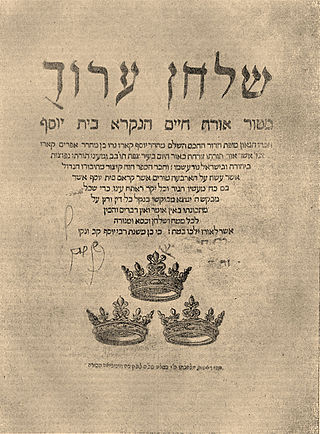
The Shulchan Aruch, often dubbed in English as the Code of Jewish Law, is the most widely consulted of the various legal codes in Judaism. It was authored in Safed, Ottoman Syria by Joseph Karo in 1563 and published in Venice two years later. Together with its commentaries, it is the most widely accepted compilation of halakha or Jewish law ever written.
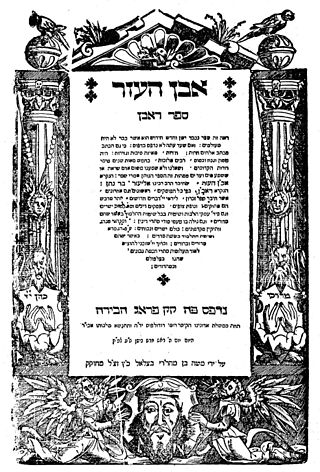
Eliezer ben Nathan of Mainz (1090–1170), or Ra'avan, was a halakist and liturgical poet. As an early Rishon, he was a contemporary of the Rashbam and Rabbeinu Tam, and one of the earliest of the Tosafists. He was the son-in-law of Eliakim b. Joseph of Mainz, a fellow student of Rashi. Through his four daughters Eliezer became the ancestor of several learned families which exerted a great influence upon religious life in the subsequent centuries. One of his great-grandsons was Asher b. Jehiel (ROSH), father of R. Jacob, author of the Ṭurim.

Jacob ben Asher, also known as Ba'al ha-Turim as well as Yaakov ben haRosh, was an influential Medieval rabbinic authority. He is often referred to as the Ba'al ha-Turim, after his main work, the Arba'ah Turim.
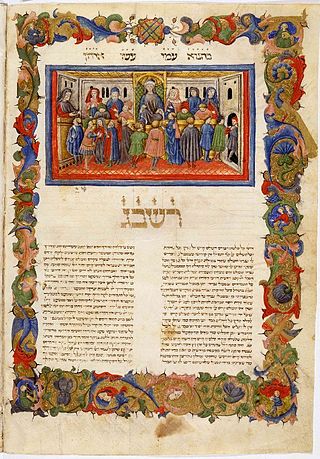
Arba'ah Turim, often called simply the Tur, is an important Halakhic code composed by Yaakov ben Asher. The four-part structure of the Tur and its division into chapters (simanim) were adopted by the later code Shulchan Aruch. This was the first book to be printed in Southeast Europe and the Near East.
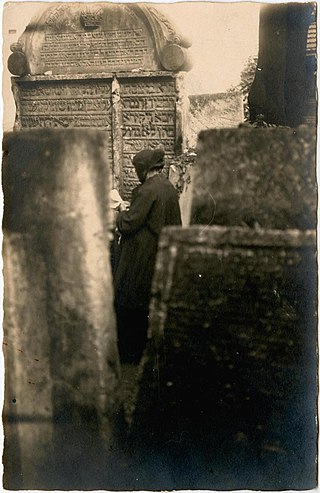
Yehoshua ben Alexander HaCohen Falk was a Polish Halakhist and Talmudist, best known as the author of the Drisha and Prisha commentaries on the Arba'ah Turim as well as Sefer Me'irat Enayim (סמ"ע) on Shulkhan Arukh. His name also occurs as the Hebrew acronyms רפ"כ ("RaFaC"), מהרו"כ ("Ma-HaRWaC"), and מהר"י כ"ץ.

Orach Chayim, is a section of Rabbi Jacob ben Asher's compilation of Halakha, Arba'ah Turim. This section addresses aspects of Jewish law pertinent to the Hebrew calendar. Rabbi Yosef Karo modeled the framework of the Shulkhan Arukh, his own compilation of practical Jewish law, after the Arba'ah Turim. Many later commentators used this framework, as well. Thus, Orach Chayim in common usage may refer to another area of halakha, separate from Rabbi Jacob ben Asher's compilation.
Yoreh De'ah is a section of Rabbi Jacob ben Asher's compilation of halakha, the Arba'ah Turim, written around 1300. This section treats all aspects of Jewish law not pertinent to the Hebrew calendar, finance, torts, marriage, divorce, or sexual conduct.. Yoreh De'ah is therefore the most diversified area of Jewish law. Later, Rabbi Yosef Karo modeled the framework of his own compilation of practical Jewish law, the Shulchan Aruch, after the Arba'ah Turim. Many later commentators used this framework, as well. Thus, Yoreh De'ah in common usage may refer to an area of halakha, non-specific to Rabbi Jacob ben Asher's compilation.
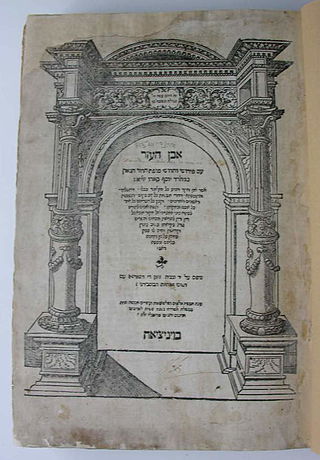
Even Ha'ezer is a section of Rabbi Jacob ben Asher's compilation of halakha, Arba'ah Turim. This section treats aspects of Jewish law related to marriage, divorce, and sexual conduct. Later, Rabbi Yosef Karo modeled the framework of his own compilation of practical Jewish law, the Shulchan Aruch, after the Arba'ah Turim. Many later commentators used this framework as well. Thus, "Even Ha'ezer" in common usage may refer to an area of halakha non-specific to Rabbi Jacob ben Asher's compilation.
Samson ben Abraham of Sens ,was one of the leading French Tosafists in the second half of the 12th and the beginning of the 13th centuries. He was the most outstanding student and the spiritual heir of Rabbi Isaac ben Samuel ha-Zaken. He is referred also known as "the Rash" or "the Prince of Sens", and within Tosafot as "Rashba".
Joseph Escapa served in the rabbinate of İzmir. He was probably born at Skopje, Ottoman Empire back then, after which he is named.
Abraham ben Isaac of Narbonne (c. 1080-85 – 1158) was a Provençal rabbi, also known as Raavad II, and author of the halachic work Ha-Eshkol.
Alexander SuslinHaKohen was a prominent 14th century rabbinic authority born in Erfurt, Germany, and one of the most important Talmudists of his time. He was rabbi first in Cologne and Worms, and then moved to Frankfort-on-the-Main. He authored Sefer HaAguddah, a halakhic work which was highly regarded by later rabbinic authorities. He was killed in the Erfurt massacre of 1349 during the Black Death era massacres of hundreds of Jewish communities throughout Europe.
Aaron Samuel ben Israel Kaidanover was a Polish-Lithuanian rabbi. Among his teachers were Jacob Hoeschel and his son Joshua Hoeschel.
Kol Bo is a collection of Jewish ritual and civil laws. Its author has not yet been ascertained. The work in content resembles other codes, as, for instance, the Orḥot Ḥayyim, though in its form it is very different.
Beit Yosef, written by Rabbi Joseph Karo, is a long and detailed commentary on the Halakhic code Arba'ah Turim ("Tur") by Jacob ben Asher. The Shulchan Aruch, which Rabbi Karo wrote later in his life, is a condensation of its rulings.
Hachmei Provence refers to the hekhamim, "sages" or "rabbis," of Provence, now Occitania in France, which was a great center for Rabbinical Jewish scholarship in the times of the Tosafists. The singular form is hakham, a Sephardic and Hachmei Provençal term for a rabbi.

A meshulach, also known as a shaliach or SHaDaR, was an emissary sent to the Diaspora to raise funds (ḥalukka) for the existence of the Jewish settlement in the Land of Israel. The institution of the Emissaries of the Land of Israel, which began in ancient times, developed and contributed greatly to the connection between Diaspora Judaism and the Jews in the Land of Israel, and to the cultural life of the Jewish communities.
Ḥayyim Yitzḥak Mussafia was an 18th- and 19th-century Talmudist.
References
- ↑ Joseph Karo, Kesef Mishneh, Hilchot Shofar Sukkah veLulav, chapter 1
- ↑ Yitzchak Sheilat, הדורות האחרונים של חכמי פרובנס, minute 12
- ↑ Al Harishonim veAl HaAchronim (Machon Tzurba deRabanan), 4th edition
 This article incorporates text from a publication now in the public domain : Singer, Isidore; et al., eds. (1901–1906). "Aaron ben Jacob ben David HaKohen". The Jewish Encyclopedia . New York: Funk & Wagnalls. Its bibliography:
This article incorporates text from a publication now in the public domain : Singer, Isidore; et al., eds. (1901–1906). "Aaron ben Jacob ben David HaKohen". The Jewish Encyclopedia . New York: Funk & Wagnalls. Its bibliography:- Henri Gross, "Aaron ha-Kohen und sein Ritualwerk Orḥot Ḥayyim," in Monatsschrift, 1869, pp. 433–450, 531-541
- idem, Gallia Judaica, pp. 290, 420;
- Heimann Joseph Michael, Or ha-Ḥayyim, No. 300; Benjacob, Oẓar ha-Sefarim, pp. 51, 239